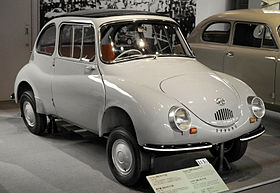| Subaru 360 | |
|---|---|
 | |
| Overview | |
| Manufacturer | Subaru |
| Also called | Subaru 450[1] K-10 (prototype)[2] |
| Production | 1958–1971 |
| Assembly | Japan: Otakita Plant, Ōta, Gunma |
| Designer | Shinroku Momose |
| Body and chassis | |
| Class | Microcar |
| Body style |
|
| Layout | RR layout |
| Doors | Suicide doors |
| Related | Subaru Sambar |
| Powertrain | |
| Engine | |
| Dimensions | |
| Wheelbase | 1,801 mm (70.9 in) |
| Length | 2,990 mm (117.7 in) |
| Width | 1,300 mm (51.2 in) |
| Height | 1,379 mm (54.3 in) |
| Curb weight | 410 kg (900 lb) |
| Chronology | |
| Successor | Subaru R-2 |
The Subaru 360 is a rear-engined, two-door city car manufactured and marketed by Subaru from 1958 to 1971. As the company's first mass-produced automobile, production reached 392,000 over its 12-year model run.
Noted for its small overall size, 450 kg (1,000 lb) curb weight, monocoque construction, swing axle rear suspension, fiberglass roof panel, and rear-hinged doors, the inexpensive car was designed in response to the Japanese government's light car or Kei car regulations and its proposal for a larger "national car," both intended to help motorize the post WWII Japanese population. The 360's overall size and engine capacity complied with Japan's Kei car regulations.
Nicknamed the "ladybug" in Japan, and ultimately superseded by R-2, the 360 was one of Japan's most popular cars and was available in a single generation in two-door, station wagon ("Custom"), "convertible" (a sedan with a roll-back fabric roof) and sporting variants. The two-door sedans' model code is K111, while the wagon is known as K142. Ten thousand were sold in the United States, imported by Malcolm Bricklin and advertised as "Cheap and Ugly."[3]
The nameplate 360 derived from its tax-limited engine displacement: 356 cc.
- ^ "New Subaru", The Autocar, 4 November 1960, page 821
- ^ "Subaru History". Subaru Global. Subaru Corporation. Retrieved 10 April 2017.
- ^ Preston, Benjamin (January 30, 2014). "What Would You Do with Eight Tiny Subarus?". The New York Times.